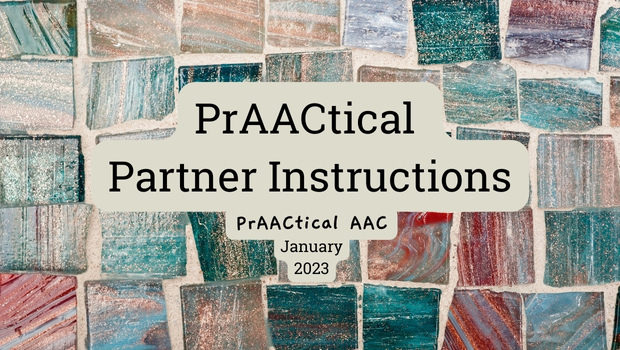PrAACtical Partner Instructions

While training communication partners is an important role for SLPs and other professionals, there’s an additional way to promote supportive interactions. Empower AAC users to give instructions to their communication partners. Prestoring partner instructions and teaching AAC users how to utilize them improves their ability to advocate for themselves.
What partner instruction messages might be helpful? It depends on the individual situation, but here are some ideas to get spark your creativity.
- Tell them what to expect
- I use this special computer to talk. I understand everything you say, but it takes time for me to respond. Please be patient and let me put together my message after you ask a question.
- This assistive technology is one of the ways that I communicate. I choose messages with my eyes and it takes a while for me to do that. You’ll hear each word as I choose it but wait until I’m finished before responding. I’ll look up when I’m ready and will say the whole message. Let me know if you need me to repeat anything.
- Tell them where to stand
- Stand in front of me where I can see you.
- Can you get a little closer/farther away?
- Would you mind bending/kneeling down so I can see your face?
- You’re a little too close. I need some space.
- Tell them what to do
- Wait while I put my message together.
- Tell me if you don’t understand.
- Ask one question at a time so I can answer clearly.
- Slow down, please.
- Tell me what’s going on.
- Repeat each letter as I point to it.
- Explain it to me.
- Speak up, please.
- Can you use a softer voice? You’re being a little too loud.
- Ask me a yes/no question.
- Tell me if you’re not sure what to do.
- Give me a hint.
- Show me what to do.
- Check my device troubleshooting card. Something’s not right.
- Tell them what to avoid
- Don’t ask two questions at the same time.
- Stop hovering.
- Don’t use a baby voice when you talk to me.
- Please don’t touch/help me.
- Don’t rush me.
- Stop moving/leaning on/touching my wheelchair, please.
Do you have additional suggestions for partner instructions? We’d love to hear about them.
Filed under: PrAACtical Thinking
This post was written by Carole Zangari

2 Comments
I’m glad to see a post on this important topic. I include a full page of partner instructions in my AlphaCore pagesets. One I find helpful is: “When I want to say “yes “ I do this. Watch me.“. While, we may know to ask people what their yes and their no indication looks like, most people don’t ask this. Providing a quick way for the AAC user to establish what their yes and no looks like is so immediately useful. It also prevents having unfamiliar communication partners make suggestions about what they should use for yes and no when they already have a way.
Thanks for sharing that, Amy. Much appreciated!